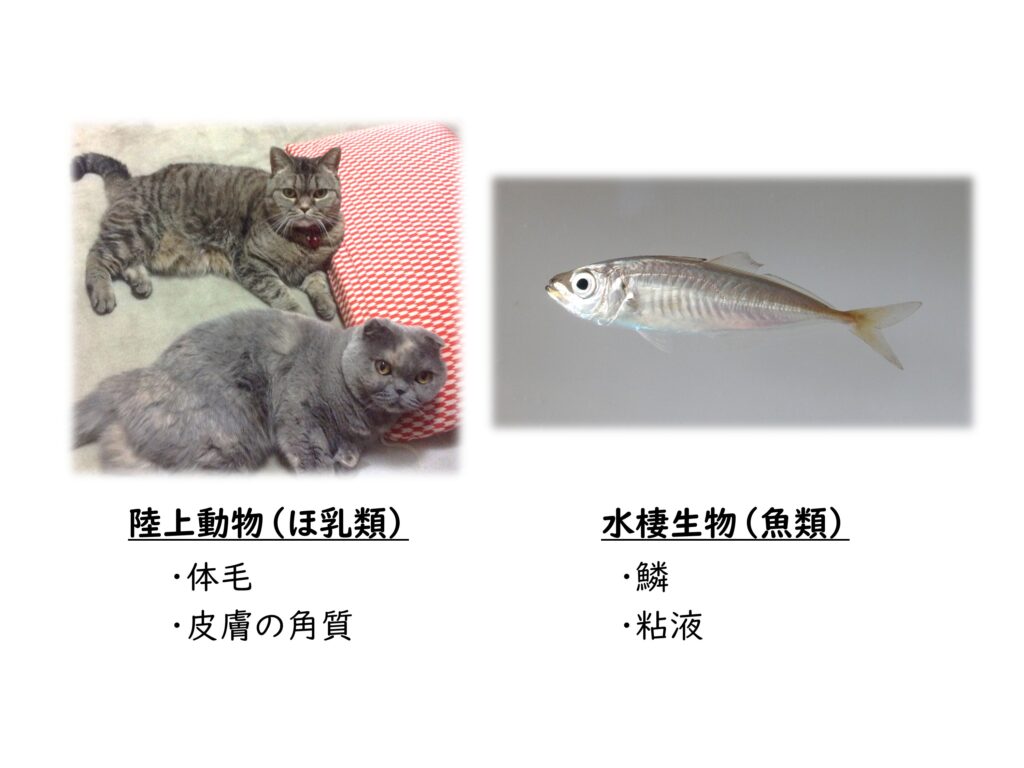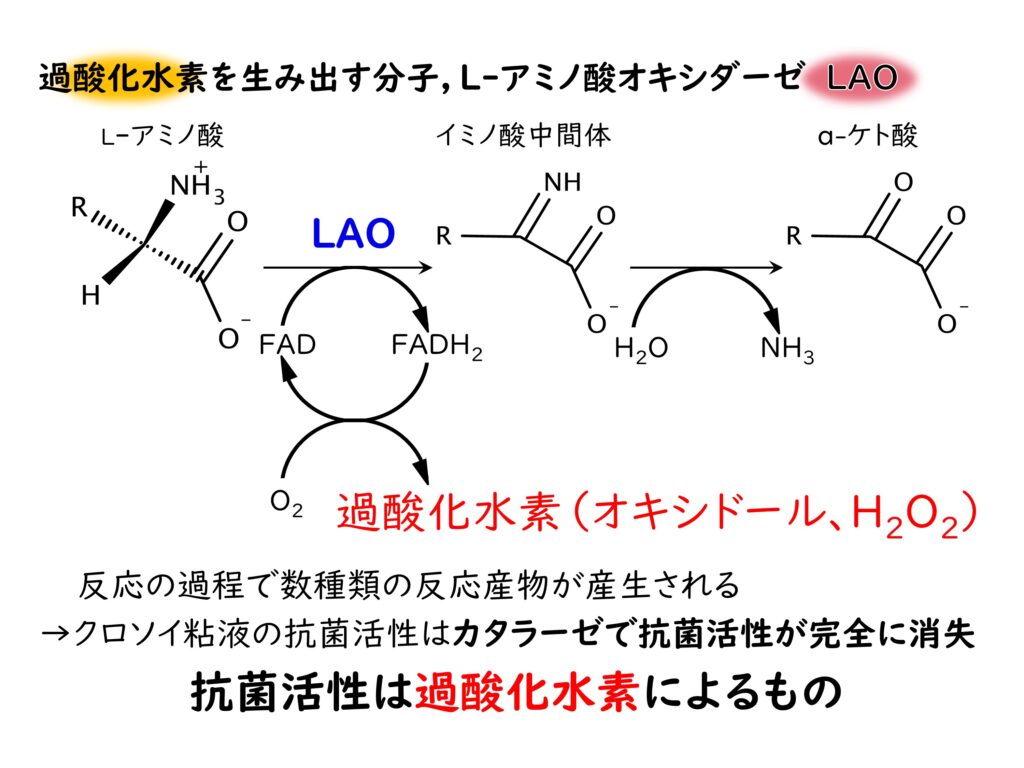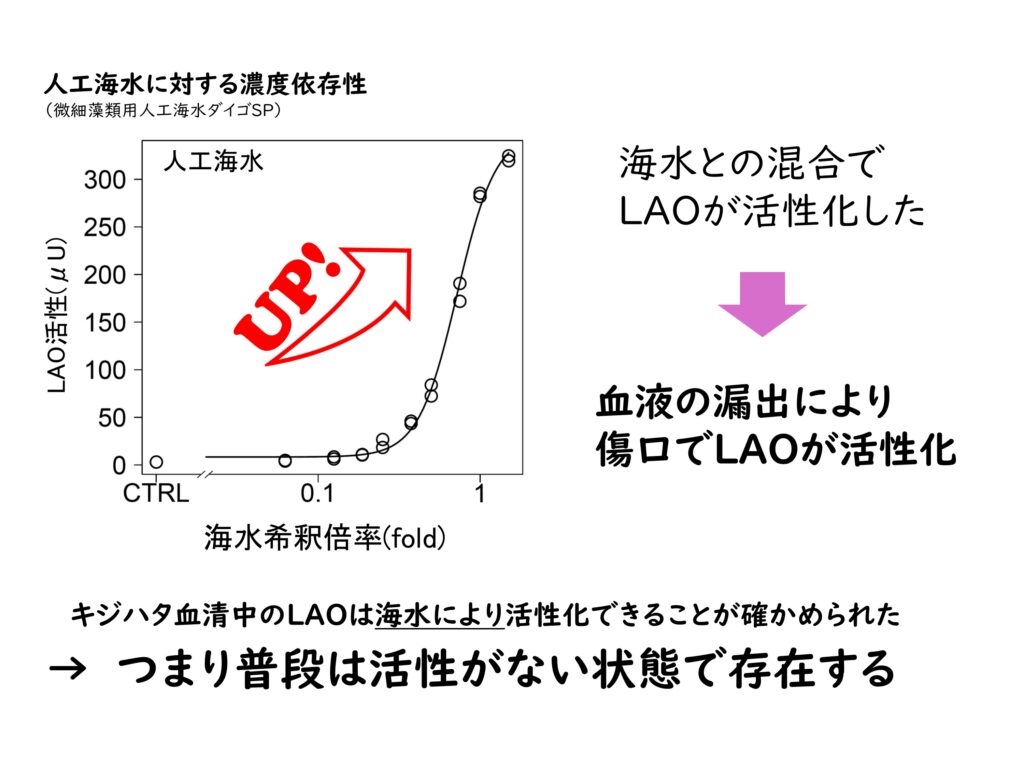魚類も病気になることが知られています。とくに体の表面である皮膚や鰓は陸上動物とは異なり柔らかい細胞で覆われていたり,また病原生物とふれあう機会がおおいため,これらが侵入しやすい組織でもあります。
一方,病気に対抗するちから「免疫系」も持ち合わせています。これは私たち人間ととても類似した仕組みを備えていますが,魚類の免疫系は原始的です[1]。
そのため,魚類の体表には特別な生体防御物質を持つものが多くいます[2]。わたしたちは, L-アミノ酸オキシダーゼ(LAO)という物質が強い抗菌作用を示すことで魚類の生体防御物質として機能していることを明らかとしました[3]。
LAOはL-アミノ酸を分解する酵素で,副産物として過酸化水素などが生まれます。過酸化水素は消毒薬であるオキシドールの薬効成分でもあるほど細菌などの繁殖を抑える強いちからがあります。LAOが抗菌作用を示す原因は,この過酸化水素によるものです[4]。
また,研究の過程で魚類の血液にもLAOが存在することをあきらかとしました[5,6]。しかし,血液中にLAOが存在すると栄養として存在するアミノ酸が分解され,さらに過酸化水素など毒性のある副産物が体内で発生してしまい,魚が弱ってしまいそうです。
魚はこの問題を上手に解決していました。キジハタという魚の血液に含まれるLAOは体内ではスイッチが切れた状態で存在し,海水と混じることでスイッチがオンになり過酸化水素を発生することができるようです[7]。
血液中には細菌を死滅させるために十分なL-アミノ酸が含まれることも確かめられました[8]。おそらく血液中のLAOはケガをした傷口から細菌が入り込まないように,魚自身が消毒薬を自分でつくって身を守るために役立てているようです。
LAOはすべての魚類に存在するものではないこともわかってきました。原始的な細菌や[9]進化が進んだ哺乳類[10]にもLAOが存在するため,その中間の魚類はすべての種でLAOをもっていそうです。しかしながら魚類の一部からしかLAOの作用が検出されません。どのような魚類にLAOがあるのか,どの細胞がLAOを作っているのか,毒性の強い物質でもあるLAOをなぜ生体防御物質として魚類はわざわざ利用しているのか,これらがわかれば眠っているLAOのちからを呼び起したり,ほかの生き物におけるLAOの役割を推定できるようになるかもしれません。残されたたくさんの謎を解決するためにわたしたちの研究室では活動をつづけています。
[1] L. Tort, J.C. Balasch, S. Mackenzie, Fish immune system. A crossroads between innate and adaptive responses, Inmunologia 22 (2003) 277–286. https://www.inmunologia.org/Upload/Articles/6/0/602.pdf (accessed March 14, 2019).
[2] S. Rakers, M. Gebert, S. Uppalapati, W. Meyer, P. Maderson, A.F. Sell, C. Kruse, R. Paus, “Fish matters”: The relevance of fish skin biology to investigative dermatology, Exp Dermatol 19 (2010) 313–324. https://doi.org/10.1111/j.1600-0625.2009.01059.x.
[3] Y. Kitani, C. Tsukamoto, G. Zhang, H. Nagai, M. Ishida, S. Ishizaki, K. Shimakura, K. Shiomi, Y. Nagashima, Identification of an antibacterial protein as L-amino acid oxidase in the skin mucus of rockfish Sebastes schlegeli., FEBS J 274 (2007) 125–136. https://doi.org/10.1111/j.1742-4658.2006.05570.x.
[4] R.C. Skarnes, L-Amino-acid Oxidase, a Bactericidal System, Nature 225 (1970) 1072–1073. https://doi.org/10.1038/2251072a0.
[5] Y. Osaka, Y. Kitani, Blood loss induces L-amino acid oxidase gene expression in the head kidney of the red-spotted grouper, Epinephelus akaara, Dev Comp Immunol 114 (2021) 103842. https://doi.org/10.1016/j.dci.2020.103842.
[6] Y. Kitani, M. Ishida, S. Ishizaki, Y. Nagashima, Discovery of serum L-amino acid oxidase in the rockfish Sebastes schlegeli: Isolation and biochemical characterization, Comparative Biochemistry and Physiology - B Biochemistry and Molecular Biology 157 (2010) 351–356. https://doi.org/10.1016/j.matchemphys.2015.05.051.
[7] Y. Kitani, Y. Osaka, S. Ishizaki, Seawater activates L-amino acid oxidase from the serum of the red-spotted grouper Epinephelus akaara, Fish Shellfish Immunol 120 (2022) 222–232. https://doi.org/https://doi.org/10.1016/j.fsi.2021.11.035.
[8] Y. Kitani, Red-spotted grouper Epinephelus akaara blood l-amino acid oxidase utilizes the substrates in plasma, Fisheries Science 88 (2022) 635–643. https://doi.org/10.1007/s12562-022-01617-x.
[9] H. Suzuki, Y. Higashi, M. Asano, M. Suguro, M. Kigawa, M. Maeda, S. Katayama, E.B. Mukouyama, K. Uchiyama, Sequencing and Expression of the L-Phenylalanine Oxidase Gene from Pseudomonas sp. P-501. Proteolytic Activation of the Proenzyme, The Journal of Biochemistry 136 (2004) 617–627. https://doi.org/10.1093/jb/mvh169.
[10] C.C. Chu, W.E. Paul, W.I.E.P. Aul, Fig1, an interleukin 4-induced mouse B cell gene isolated by cDNA representational difference analysis., Proc Natl Acad Sci U S A 94 (1997) 2507–12. http://www.pubmedcentral.nih.gov/articlerender.fcgi?artid=20118&tool=pmcentrez&rendertype=abstract.


